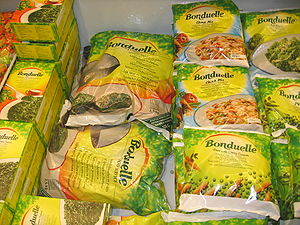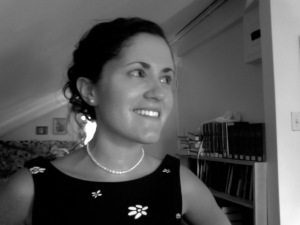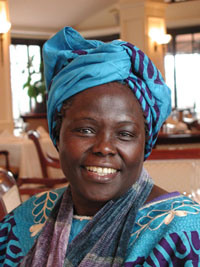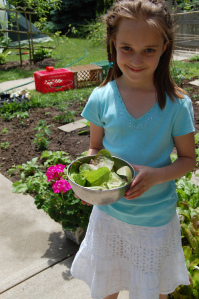I’ve decided to take Sundays off from writing and, instead, post a single photo capturing some aspect of Sabbath–rest, peace, comfort, connection, praise, help–things like that. Today’s is about connecting/celebrating.
Tag Archives: family
Silliness.
In Defense of Frozen Food
“I can’t eat local–what would I possibly eat in January–turnips?!”
Not necessarily. Because whether you grow your own food or purchase locally grown food, you can PRESERVE some of it for winter! And it doesn’t have to be complicated. You don’t need any special skills or equipment, unless boiling water is beyond your skill-set and a colander isn’t among your kitchen tools. And you know what? Many, many vegetables are BEST preserved by freezing rather than canning. (Think of the difference between frozen green beans and canned–which is most like fresh?)

True, some of the flavor and texture is lost through the freezing process, which is why you will prepare your frozen veggies differently than you would if they were fresh. You might make a Caprese salad with fresh tomatoes, like so:
But you couldn’t replicate that salad in winter by pulling out the frozen tomatoes. You could, however, put them into any number of delicious soups, stews, and sauces. And, as Barbara Kingsolver points out, since they won’t have traveled any distance in the meantime–they’ll still be local.
“But what about VITAMINS? Aren’t fresh vegetables healthier than and preferable to frozen ones?!”
Actually, very few vitamins are lost in the freezing process. Even commercially frozen foods can be nutritionally superior to their fresh (but imported) counterparts, because food is frozen at the peak of freshness. By contrast, fresh vegetables transported long distances lose a marked amount of vitamins over the course of their trip from the field to your plate.
And as to the question of environmental friendliness, I certainly feel better about buying US-grown frozen broccoli in December than buying broccoli that has been shipped FROM CHILE.

To reiterate–you don’t necessarily have to grow your own. In fact, if you can find a local source for vegetables (and no matter where you live, you probably can), you may get a discount for purchasing a large amount in bulk. This helps the farmer and it helps you–if you know how to preserve the food. For example, local farmstands where I live are currently charging about 70 cents per ear of corn. If you buy a bushel (about 40 ears) it costs $10.
So what do you do with those hypothetical ears of corn? This method is the simplest and easiest and applies to many, many different vegetables:
1. Dip prepared (ie, trimmed and cut) vegetables into boiling water for 3 minutes.
2. Immediately dunk into COLD water and rinse to stop the cooking.
3. Pat dry with clean kitchen towels and pack into freezer containers/bags.

I was given a vacuum sealer, but it's in storage in California. That's what I get for moving 5x in 8 years...so these are just plain ol' freezer bags.
*UPDATE*
Ellen asked whether I have a dedicated freezer. I do–it’s one we’re borrowing from church, since they’re not currently using it. If that one wasn’t available, I’d be shopping around for a second-hand freezer, for sure. They’re quite energy-efficient (since they are opened only once in a while). Of course, space for a freezer is not always in great supply, especially if you live in an apartment (which I have done most of my adult life.) So this defense of frozen food may be somewhat unfairly biased toward home-dwellers. However, the basic point–freezing food isn’t hard!–still stands.
*END OF UPDATE*
That’s it! You can readily get more details in this book or elsewhere on the net. (UPDATE: lovely tutorial here.) Or you can ask me! (Not that I’ll know the answer, but I’d be happy to hear about whatever preservation adventures you may be on…)
Oh, and some of my favorite winter recipes take frozen vegetables very well. You can see them here!
And the best part? When you’ve frozen your own veggies in summer and fall (whether home grown or grown locally by someone else), you get a bit of a taste of the warmer months during the colder ones. And that’s fun!
Moment of Joy
Inspired by Amanda Blake Soule’s {this moment}, I’m here beginning a Friday ritual: posting a single photo from the week capturing a moment or an idea expressing something related to {family, faith, food; joyful justice & bread of life} –a Moment of Joy. If you would like to do the same, leave a link to your photo in the comments!
My Audrey Hepburn Problem
From about age 15 or so, Audrey Hepburn was my idol. I worshiped the iconic film star, watching her movies again and again, poring over books about her life, and searching for images of her online.
I could have done worse. Hepburn was, by most accounts, an extraordinarily lovely person, both inside and out. In Roman Holiday–my favorite Audrey movie–she’s lovely without trying to be, and the beauty and dignity of her character is apparent even as she portrays a very convincing princess in disguise. In her later years, she was a Goodwill Ambassador for UNICEF, having once herself been on the receiving end of emergency food aid as a child in post-WW2 Europe.
Sadly, although I admired Audrey’s humanitarian legacy and reputed grace and kindness, I was most inspired by her thinness. In the days of my Audrey obsession, her brilliant film performances were less important than the visibility of her long, lovely bones in her various stunning Givenchy and Edith Head designs. That her thinness was likely due to an eating disorder rooted in the wartime starvation she suffered as a child did not dissuade me; neither did her struggles with depression and self-loathing (which are demonstrated side effects of starvation.)
No. I saw a thin, beautiful, kind person who didn’t need to eat AND STILL had the energy to save the world. I wanted to be thin, most of all, and then be kind and save all the starving kids with the food I didn’t eat. After all, Audrey herself loved a poem that seemed to make this connection (“for a slim figure, share your food with the hungry.”) When I looked in the mirror, I saw broad shoulders and curves. I berated myself for being unable, like Audrey, to subsist on next to nothing. ‘That’s the end of me doing anything worthwhile,’ I’d think–‘what good can I do if I don’t look like Audrey? Surely that figure was the fount of all her goodness?’
Of course, this sounds crazy now. It didn’t then, partly because I was not incredibly well nourished (needed some brain food!) and partly because the idea that “you are worth something only if you look great” is a message that’s broadcasted endlessly and ubiquitously–especially to girls. Do a little experiment–listen to what people say to girls, even little ones. How many comments do you hear that are related to appearance (whether of clothing, hair, or whatever)? Do the comments that affirm (or simply call attention to) character outnumber the ones doing the same for appearance?
There are all kinds of beauty, and all kinds of ways of doing good in the world. I still like Audrey Hepburn’s movies, and I can enjoy them now without obsessing about the difference between Audrey’s figure and my own, but I still regret Hollywood’s move (beginning, some say, with Audrey) toward ever-increasing unreality in the area of women’s bodies. And so, for years now, I’ve actively looked for female role models who embody beauty that I find compelling and unusual and unrelated to body size, like Wangari Muta Maathai–women I can imagine sitting down to a meal and eating with–with gratitude and goodwill, and no guilt.
Because I want people like this girl to know that she can save the world, be beautiful in every way, and eat a great meal–and maybe all at the same time.







